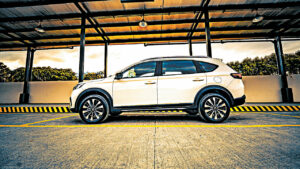Honda BR-V 1.5 S CVT: More for less, more or less

THERE IS MORE than one way to skin a cat — figuratively, of course.
That’s exactly the case in the worldwide obsession with SUVs. This fascination with larger, taller, and more powerful rides has, in turn, given rise to subgenres that — while still hewing closely to the values which have made the category so popular — offer something else.
Today’s embarrassment of riches feature a surfeit of crossovers and people-mover hybrids — more distinctly addressing the evolving tastes of a still-growing number of motorists. In this regard, you could say that brands have clearly adopted the mantra (literally, this time) “go big or go home.”
Repeatedly going to the SUV well has yielded rewards. Take the case of Honda Cars Philippines, Inc. (HCPI), which has three compelling and popular SUV/crossover vehicles here: the CR-V, the HR-V, and the entry-level volume seller that is the BR-V.
The BR-V sits in a price point that is indeed a little more attractive if you’re looking for bang-for-the-buck virtues. Sure, it breaches that psychological (and budgetary) hurdle of a million pesos, but the most affordable S variant (with a manual transmission) sits at a relatively reasonable P1.048 million — certainly perfect if your down payment appetite and monthly allocation allow for its purchase.
Since the first-generation BR-V rolled out locally in the 2016, Filipinos have taken to the model — to the tune of some 23,000 units sold since it debuted here in 2016 (worldwide, the figure is 300,000). The all-new BR-V was launched here in November of last year, and it clearly ups the ante not only for the model line but for its segment rivals.
We got behind the wheel of the S variant — the one with a CVT — and wondered if car browsers would be served well by it.
For starters, it should be known that the BR-V generally gets a bump in size versus the first generation. It stretches longer (4,490mm vs. 4,456mm), wider (1,780mm vs. 1,735mm), taller (1,685mm vs. 1,677mm); it even clears the ground higher (207mm vs. 201mm).
The upsize has resulted in more space within the vehicle as well. With the seatbacks upright, the BR-V gets 244 liters of capacity, up from 223. With the third row stowed, that number grows to 530 liters (from 521); with the second and third seatbacks collapsed, the total is 1,032 liters of goodness waiting to be conscripted for workhorse duty. To be sure, the increased capacity doesn’t only benefit cargo but passengers, too. Even third-row occupants (of reasonable size, of course), should find more than ample room for themselves.
There’s a lot of hard plastic inside, but the cabin and its appurtenances are tastefully executed to look more upscale. I love the simple and consistent black with matte-silver accents, and the intuitive layout. Everything is where it should be.
The all-new BR-V still sports a 1.5-liter power plant, but this time it’s a DOHC that supplants the old generation’s SOHC. Honda says that this results in more frugal fuel economy, despite the fact that the new BR-V is heavier at 1,298kg versus the 1,250kg of old.
It also gets going at lower torque — certainly good news for fuel economy and for more spirited driving. Keeping the S variant’s gearshift at D keeps response reasonable (read: not too quick). For the S CVT variant, HCPI (in partnership with the Automobile Association Philippines) reported a top fuel economy figure of 22.62kpl. This test was run over 128 kilometers of highway driving, with speeds of 60 to 80kph at 1,500-2,000rpm, with air-conditioning at 24°C and lowest fan speed.
My real-world, not-even-trying-to-hypermile test saw the vehicle breach double-digit figures, which means it could really have done much better if I was half-trying to save on the good stuff. So it passes the sniff test on that score.
The best thing about the BR-V, aside from its commodious cabin, is the design. I’m glad that Honda ditched the trapezoidal execution — which gave the previous generation a tall, rather unimposing gait — for a more substantial one. The BR-V now has both heft and poise to more convincingly earn a spot in Honda’s pantheon of SUVs. I’ve said in a previous piece that HCPI is stressing that the BR-V now embraces both SUV and MPV traits. “The all-new BR-V basically combines the SUV value with the MPV value and the driving experience of a Honda,” said HCPI General Manager for Sales Atty. Louie Soriano in past interview with “Velocity,” adding, “The MPV, expressed in the flexible space and seating capacity, meets the need for utility. The SUV aspect is in the high ground clearance, and comfort; then you round it out with the Honda driving experience. It’s practical and prestigious.”
If you don’t want to drive a manual, then the S CVT variant is the most affordable BR-V you can get — setting you back P1.15 million. Up a step is the V CVT, priced at P1.295 million. The more expensive variant gets (among others) a steering wheel wrapped in leather, chrome-hued door handles, silver-painted garnishes, an additional two tweeters on top of the four standard woofers, automatic air-conditioning, and leather-covered seats. If you can live with the differences (and I can’t see why not), then the S CVT should do the trick nicely.
This model certainly punches above its price point — a great option for people looking to upgrade from, say, a smaller sedan or even a more modest MPV or mini SUV. In the BR-V, you’ll tick a lot of the important boxes that make SUVs such a popular category, and end up with a lot of money left in the bank.




